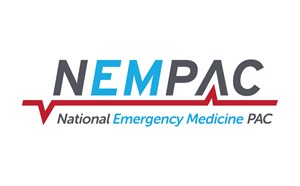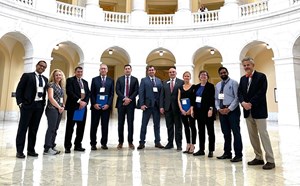
Update on the No Surprises Act (NSA)
Background

The No Surprises Act (NSA) was passed at the close of the 116th Congress in December 2020 as part of the year-end Consolidated Appropriations Act of 2021. The law was passed after years of bipartisan negotiations with input from many stakeholders, including ACEP on behalf of the emergency physician community. The law was created to “take patients out of the middle” and protect them financially in situations where they received care from an out-of-network (OON) physician, facility, or air ambulance (which are collectively called “providers” under the law). The law provides an opportunity for “open negotiation” and if necessary, neutral arbitration by an Independent Dispute Resolution Entity (IDRE) if providers believe they have not been paid an appropriate amount for the service and care delivered.
While the law has accomplished its primary goal of protecting patients, the regulations written and the operational implementation of the law by the Biden Administration has created significant challenges for the provider community. The regulations and operational processes now implementing the law have unfairly advantaged the insurers and allowed them to weaponize the law against providers. Insurers are using the lack of transparency requirements and absence of meaningful oversight by the administration to pay emergency physicians far less than they should be for patients with commercial insurance. Not only are emergency physicians who provide EMTALA mandated care on an OON basis being paid ridiculously low reimbursement amounts, providers with long-standing in-network contracts are now seeing those contracts terminated by insurance companies, for no cause, and “offered” the opportunity to stay in-network at much lower rates. The provider community, including ACEP, are fighting back to protect the ability of physicians to be fairly reimbursed for the care we provide.
Key Aspects of the Law & Regulations - What went wrong?
1. The QPA gone bad - Under the NSA, when care is provided in an OON situation, the insurer is technically not required to pay the provider anything but are required to calculate an amount called the Qualifying Payment Amount (QPA) for the purposes of calculating the patient’s financial responsibility. The QPA is defined as the median of the contracted rates that the insurer had in place on January 31, 2019, for the same or similar service for a specific provider type in the same geographic area that the care was provided in, which is then supposed to be inflated by the Consumer Price Index for All Urban Consumers (CPI-U) for each year since 2019. Sounds simple, except that the insurers are allowed to treat every in-network contract the same in the calculation, regardless of how many times that contract rate was used. This has led to the belief that insurers are including “ghost rates” in the calculation and artificially lowering the QPA amount. And, although the QPA was never intended to be the “fair market reimbursement” that providers were still supposed to be receiving under the law, the reality is that many insurers are only paying the QPA amount. Because there is no requirement that the insurers disclose how they calculated the QPA, providers are at a significant disadvantage in proving that the insurer has incorrectly, and illegally, calculated the QPA. Making a bad situation with the QPA worse is the fact that the administration has created no audit process to ensure that insurers are not violating the law and have provided no response to thousands of complaints that have been filed alleging that the insurers are violating the law. There are ongoing reports by emergency physicians that they are seeing QPA amounts, which are required to be calculated from commercial contracts only in place in January 2019, with no Medicare or Medicaid rates, at amounts less than 100% of the 2022 Medicare rate. Payment rates at these levels are inconsistent with any “reasonable person” test.
2. The administration “overweighting” the QPA - Under the NSA, if providers and insurers end up in arbitration, the law requires the arbitrator to consider several factors in determining whether the provider’s or insurer’s final offer reflects the most appropriate payment amount. These factors include:
- the QPA amount
- the level of training or experience of the provider or facility
- quality and outcomes measurements of the provider or facility
- market share held by the out-of-network health care provider or facility, or by the plan or issuer in the geographic region in which the item or service was provided
- patient acuity and complexity of services provided, teaching status, case mix, and scope of services of the facility
- any good faith effort—or lack thereof—to join the insurer’s network; and any prior contracted rates over the previous four years
The Biden Administration, despite this clear legislative language, tipped the scales in the insurers favor by writing regulations and giving guidance in July 2021, to the IDREs by creating a “rebuttable presumption” that the QPA number alone was the “right” amount to pick in determining which final offer was most appropriate. After a ruling against this language by a federal judge (read below for more on this), the administration essentially doubled down in writing the “final rule” on the NSA in August 2022, in which they changed some of the wording around the consideration of the six factors. This continued to effectively tell the IDREs to consider the QPA as the only factor by asserting that all of the other factors were already included in the QPA, and therefore would be “double counted” if considered separately.
3. So much more bad stuff - In addition to the two major issues with the implementation of the NSA noted above, there are several other operational, timeline, and administrative issues with the way the administration is using this law to disadvantage providers. Although there isn’t room in this article to go through them all, just know that ACEP is working to address those too.
Fighting Back
So, what is ACEP doing to fight back against the insurers and administration? ACEP continues to push the administration through multiple comment letters and direct meetings, documenting the inequities of how the regulations and implementation of the law are hurting providers. ACEP has authored, or co-authored with EDPMA, more than a dozen letters to the administration providing information on how the law and regulations are being unfairly used and leading to a decrease in the overall amount of in-network care being provided to patients, which is exactly the opposite of what legislators wanted in developing the NSA. Second, ACEP continues to work with those Members of Congress who were the legislative champions in the writing of the NSA to have them put pressure on the administration to change the regulations so there is no advantage to insurers.
Lastly, ACEP has submitted amicus briefs with the court in support of the lawsuits that have been filed by the Texas Medical Association (TMA) against the administration for it’s unfair, and improper, implementation of the law. As referenced above, the first of these lawsuits, which we’ll call “TMA 1,” was already decided by the federal district court in the Eastern District of Texas. The court’s ruling there vacated the language in July 2021 that created the “rebuttable presumption” of the QPA being the “right” answer. Unfortunately, the administration again included language in the August 2022 Final Rule that, although using different words, effectively created the same guidance for IDREs that the QPA was the “right” amount by creating a new concept of “double counting.”
In response to the language in the Final Rule, the “TMA 2” lawsuit was filed, again in the Eastern District Court of Texas alleging that the administration has again overstepped their authority and has implemented the law incorrectly. The “TMA 2” hearing was held on December 20, 2022, and we are currently awaiting the court’s ruling. In the meantime, a “TMA 3” lawsuit has also been filed. This lawsuit (yep, you guessed it, filed in the Eastern District of Texas) alleges that the formula used to calculate the QPA allows for an incorrect calculation of what was supposed to reflect “fair market” rates and should therefore be changed.
These lawsuits, if the court rules in favor of TMA, will provide a powerful tool for ACEP and other provider groups to push the administration to finally implement the law in the way the bipartisan legislative process intended it to be.
Stay tuned - as we await the ruling in the “TMA 2” lawsuit, ACEP continues to work with other specialty societies and provider stakeholders to pressure the administration to just “do the right thing” and implement the law fairly. In all our comment letters, public statements, and meetings with the administration, ACEP and other stakeholders warned the administration that given the opportunity to weaponize the law, insurers would do just that.
Unfortunately, exactly what we warned would happen, has happened. Insurers are paying unfairly low reimbursements, the QPA calculation is opaque and clearly does not reflect fair market commercial payments, and insurers are canceling in-network contracts to blackmail providers into accepting lower reimbursements for care provided. This is of course, in the setting of insurers declaring record-breaking profits on a quarterly basis. ACEP is, and will continue to, fight against these bad behaviors to ensure that emergency physicians are fairly and appropriately compensated for the care we provide.
If you want to find more information on the implementation of the NSA, you can go the website. If you have any questions about the NSA, please feel free to reach out to me or folks in the ACEP DC office.
L. Anthony Cirillo, MD, FACEP
Board Liaison
Emergency Medicine Practice Management Health Policy Section



